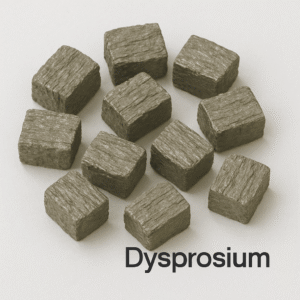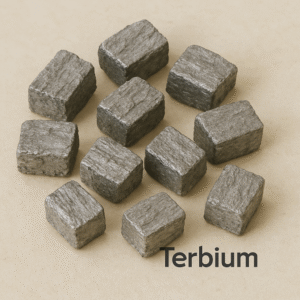Your cart is currently empty!
Thulium (Tm)
Basic Information Element Name: Thulium Symbol: Tm Atomic Number: 69 Atomic Weight: 168.93 Element Category: Lanthanide (Rare Earth Element) Standard State: Solid Appearance: Silvery-gray, soft, and ductile metal Chemical and Physical Properties Density: 9.32 g/cm³ Melting Point: 1,545 °C (2,813 °F) Boiling Point: 1,950 °C (3,542 °F) Electronegativity (Pauling scale): 1.25 Oxidation State: +3 (stable), +2 (less common) Magnetism: […]
Description
Basic Information
-
Element Name: Thulium
-
Symbol: Tm
-
Atomic Number: 69
-
Atomic Weight: 168.93
-
Element Category: Lanthanide (Rare Earth Element)
-
Standard State: Solid
-
Appearance: Silvery-gray, soft, and ductile metal
Chemical and Physical Properties
-
Density: 9.32 g/cm³
-
Melting Point: 1,545 °C (2,813 °F)
-
Boiling Point: 1,950 °C (3,542 °F)
-
Electronegativity (Pauling scale): 1.25
-
Oxidation State: +3 (stable), +2 (less common)
-
Magnetism: Paramagnetic
Reactivity and Storage
Thulium is moderately reactive. It tarnishes slowly in air, reacts with acids, and forms oxides in moist environments. It should be stored under mineral oil or in inert gas to prevent oxidation. Compared to other lanthanides, it is relatively easy to handle and stable in solid form.
Occurrence and Extraction
Thulium is one of the least abundant lanthanides, but it is still more common than some precious metals like silver. It is found in minerals such as monazite, xenotime, and gadolinite, and is separated from other rare earth elements using ion-exchange and solvent extraction techniques.
Isotopes
-
Naturally occurring thulium consists of a single stable isotope: Tm-169
-
Tm-170, a radioactive isotope, is used in portable X-ray devices
Key Applications
1. Medical Lasers
-
Tm-doped fiber lasers (typically emitting at ~1.94 μm) are used in:
-
Urology (e.g., kidney stone treatment)
-
ENT surgery
-
Minimally invasive procedures
-
-
Known for high precision, minimal thermal damage, and compatibility with soft tissue
2. Portable X-ray Sources
-
Radioactive Tm-170 emits soft X-rays and is used in:
-
Compact, portable X-ray machines
-
Industrial defect detection
-
Emergency field medical imaging (in remote locations)
-
3. High-Temperature Alloys
-
Thulium is used as a component in specialized alloys to improve mechanical strength and temperature resistance
-
Applied in aerospace and military-grade materials
4. Nuclear Reactors
-
Tm is being investigated for use in control rods and neutron shielding materials due to its neutron-absorbing properties
5. Electronics and Magneto-Optic Devices
-
Tm-doped materials are used in magneto-optic memory systems and solid-state thin films
-
Also used in optical isolators and sensors for telecommunications
6. Phosphors and Luminescent Materials
-
Thulium compounds are used in blue phosphors for low-energy lighting and display technologies
-
Also used in upconversion materials for lasers and biomedical imaging
Interesting Facts
-
Discovered in 1879 by Swedish chemist Per Teodor Cleve
-
Named after Thule, the ancient Greek name for a mythical far-northern land
-
Although one of the least abundant rare earth elements, thulium’s applications in medical and laser technology are growing steadily
-
It emits a bright blue-green glow in certain compounds, making it useful in security inks and anti-counterfeit tags
Additional information
| Weight | 1 lbs |
|---|---|
| Dimensions | 1 × 1 × 1 in |
| Weight | 100G |
-
Cerium (Ce)
$257.00 -
Dysprosium (Dy)
$670.00 -
Erbium (Er)
$174.00 -
Europium (Eu)
$1,550.00 -
Gadolinium (Gd)
$106.00






